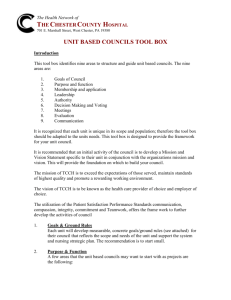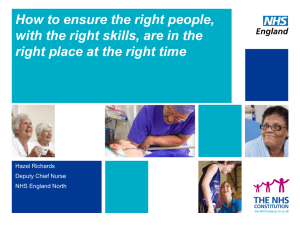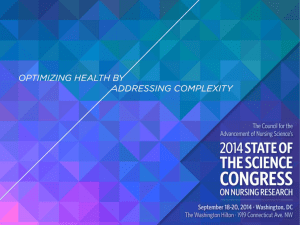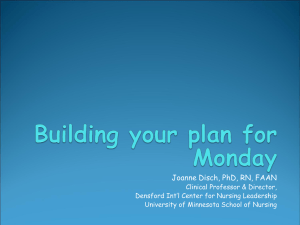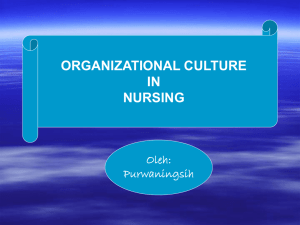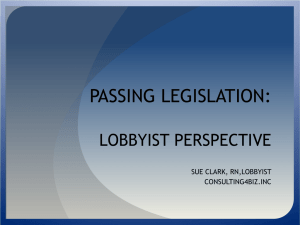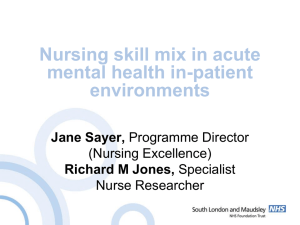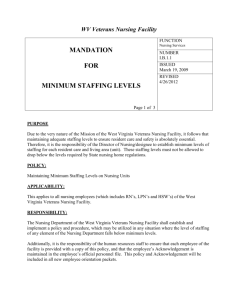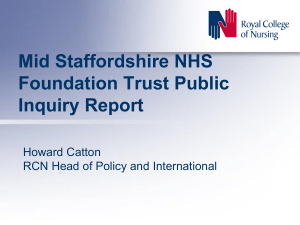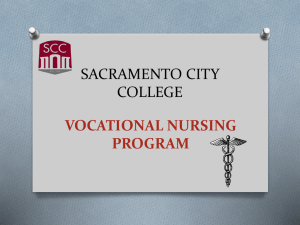Nursing & Midwifery Future – Ruth May
advertisement
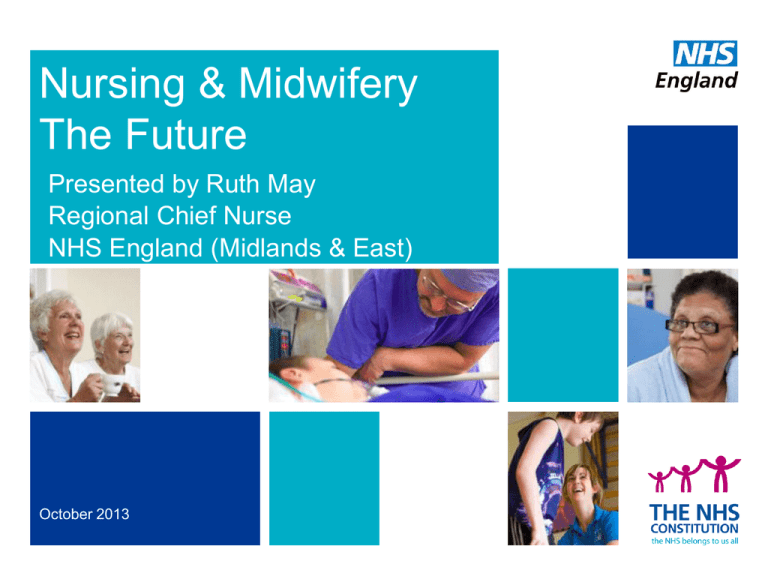
Nursing & Midwifery The Future Presented by Ruth May Regional Chief Nurse NHS England (Midlands & East) October 2013 Wider Policy Context The Keogh Review Main findings: • a limited understanding of and failure to genuinely listen to patients and staff • the poor use of data to drive quality • the complexity of using and interpreting aggregate measures of mortality, including HSMR and SHMI • some hospital trusts are operating in geographical, professional or academic isolation • the lack of value and support being given to frontline clinicians, particularly junior nurses and doctors • the imbalance that exists around the use of transparency for the purpose of accountability and blame rather than support and improvement…some boards use data for reassurance rather than, the sometimes uncomfortable, pursuit of improvement. The Keogh Review Dissonance between nursing establishments, staff in post and staff available on each shift Inadequate staffing levels on night shifts and weekends Poor skill mix Assistant Practitioners counted in Registered Nursing numbers in some organisations Links to Compassion in Practice Workstream Berwick Recommendations Government, Health Education England and NHS England should assure that sufficient staff are available to meet the NHS’s needs now and in the future. Healthcare organisations should ensure that staff are present in appropriate numbers to provide safe care at all times and are well-supported’. ‘Boards and leaders of provider organisations should take responsibility for ensuring that clinical areas are adequately staffed in ways that take account of varying levels of patient acuity and dependency, and that are in accord with scientific evidence about adequate staffing’. Reference to NICE work and to staffing ratios Our Vision – developing the culture of compassionate care “The actions set out in this vision and strategy will change the way we work, transform the care of our patients and ensure we deliver a culture of compassionate care” Jane Cummings, Chief Nursing Officer for England Our values and behaviours are at the heart of the vision and all we do Care Compassion Competence Communication Courage Commitment Action at all levels… 1. National Actions – a range of initiatives that will be led by national bodies and regulators such as CQC, NMC, NTDA and Monitor. These will also be supported by key stakeholders such as Health Education England, the RCN and the RCM. 2. Local Actions – a range of initiatives to be led by local organisations and be supported by national bodies, creating the environment, providing leadership and giving the highest priority to achieving the culture of compassionate care. There are many examples of excellent practice in the Midlands & East region. 3. Call to Action – the overarching focus for organisations and individuals specific to each area of action. Six Areas for Action Helping people to stay independent, maximising well-being and improving health outcomes Working with people to provide a positive experience of care Delivering high quality care and measuring impact Building and strengthening leadership Ensuring we have the right staff, with the right skills in the right place Supporting positive staff experience Francis Recommendations Evidence to the inquiry suggested that the Trust did not have reliable nursing establishment figures 23 – NICE to develop evidence-based tools for establishing what each service is likely to require as a minimum in terms of staff numbers and skill mix 195 – Nurse ward managers should operate in supervisory capacity, visible to patients and staff, role model and mentor 205 – Seek and record the advice of Nursing Director on quality and safety on major change Key Objectives of Action Area Five Directors of Nursing to agree appropriate staffing levels through the application of evidence based tools All nursing and midwifery staffing levels and quality experience metrics should be discussed at a public board meeting Boards to sign off and publish evidence based staffing levels at least every six months, providing assurance regarding the impact on quality of care and patient experience Monitoring of compliance (CQC, NTDA, Monitor, Contracts) Workforce Planning Tools Tools for Acute Care: Safer Nursing Care Tool Guidance and Multipliers Updated http://shelfordgroup.org/resource/chief-nurses/safetynursing-care-tool Work in progress to develop Safer Nursing Care tool for AMUs / A&E / Children’s In-Patients IPAD-APP development to record SNCT acuity and dependency scores at the bedside and generate local reports – proof of concept stage Workforce Planning Tools Tools for Maternity – Birthrate Plus RCM publishing updated guidance in autumn 2013 Tools for Community (by April 2014)Workshop session held in August Workstream being led by the Workforce Project Board of the Community Nursing Strategy QNI undertaking review of existing tools Workforce Planning Tools Tools for Mental Health (by April 2014)Two workshop sessions held Pilots of Keith Hurst and NHSScotland tools due to commence in next few weeks Literature Review Learning Disabilities (by September 2014)Sub group met in September Literature Review Working with MH group for in-patient settings Focus on tools for community settings Good Practice Guidance National Quality Board publication 19th November Will include expectations and case studies Working with CQC regarding the potential monitoring of implementation of recommendations Themes – responsibility and accountability transparency evidence base professionalism precautionary Future Work Work with NICE to establish adequate and appropriate staffing `levels for all care settings NICE have joined Steering Group and are scoping out options `for the work programme Scoping work around supervisory status of senior sisters / `charge nurse / team leaders NNRU review of impact of 12 hour shift patterns due to `commence Questions and Discussion
